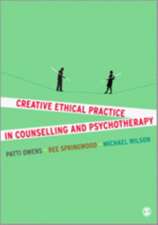Autism and the Brain: Neurophenomenological Interpretation
Autor Tatyana B. Glezermanen Limba Engleză Paperback – 19 sep 2014
Autism and the Brain offers answers by showing a new neuropsychology of the autistic spectrum, reviewing general brain organization, and relating specific regions and structures to specific clinical symptoms. The author identifies deficiencies in areas of the left-hemisphere associated with the self and identity as central to autism. From this primary damage, the brain further reorganizes to compensate, explaining the diverse behaviors among low- and high-functioning individuals as well as autistic savants. The result is a unique three-dimensional view of brain structure, function, and pathology, with in-depth focus on how the autistic brain:
Perceives the world.
Understands and uses words.
Perceives faces.
Understands spatial relations and numbers.
Understands feelings and registers emotions.
Perceives the self as separate from others.
Acts in the world.
Challenging readers to re-think their assumptions, Autism and the Brain is breakthrough reading for researchers, clinicians, and graduate students in fields as varied as child and adolescent psychiatry; clinical child, school, and developmental psychology; neuroscience/neurobiology; special education and educational psychology; social work; communication disorders; and public health and policy.
| Toate formatele și edițiile | Preț | Express |
|---|---|---|
| Paperback (1) | 1462.64 lei 6-8 săpt. | |
| Springer – 19 sep 2014 | 1462.64 lei 6-8 săpt. | |
| Hardback (1) | 1292.77 lei 6-8 săpt. | |
| Springer – 26 aug 2012 | 1292.77 lei 6-8 săpt. |
Preț: 1462.64 lei
Preț vechi: 1539.62 lei
-5% Nou
Puncte Express: 2194
Preț estimativ în valută:
279.87€ • 293.26$ • 231.37£
279.87€ • 293.26$ • 231.37£
Carte tipărită la comandă
Livrare economică 12-26 aprilie
Preluare comenzi: 021 569.72.76
Specificații
ISBN-13: 9781489998934
ISBN-10: 1489998934
Pagini: 320
Ilustrații: XVI, 304 p.
Dimensiuni: 155 x 235 x 17 mm
Greutate: 4.86 kg
Ediția:2013
Editura: Springer
Colecția Springer
Locul publicării:New York, NY, United States
ISBN-10: 1489998934
Pagini: 320
Ilustrații: XVI, 304 p.
Dimensiuni: 155 x 235 x 17 mm
Greutate: 4.86 kg
Ediția:2013
Editura: Springer
Colecția Springer
Locul publicării:New York, NY, United States
Public țintă
ResearchCuprins
Chapter I. Introduction.- Chapter II. How autistic persons understand words.- Chapter III. How autistic persons perceive the world.- Chapter IV. How autistic persons perceive faces.- Chapter V. How autistic persons act in the world.- Chapter VI. How autistic persons perceive space and spatial relations.- Chapter VII. How autistic persons feel.- Chapter VIII. Autistic persons’ sense of self.- Chapter IX. The left-hemispheric self in autism re-visited.- Chapter X. Pieces of autism’s puzzle fall into place.
Recenzii
From the reviews:
"This is a marvellous book, combining the best principles of psychopathology with the latest neuropsychological data, and I would recommend it to anyone interested in the enigma of infantile autism." (John Cutting, Cognitive Neuropsychiatry, 19:2, 184-188, August, 2013)
“Glezerman does an outstanding job of presenting the current state of knowledge of this complex and fascinating disorder. The book is well written and well researched, and it provides a sophisticated and thought-provoking analysis of the neurological correlates of autism. Psychologists, neuropsychologists, and all those interested in the study of autism should find the book very interesting.” (Linda C. Caterino, PsycCRITIQUES, Vol. 58 (25), June, 2013)
“There is potentially a large audience for this book, including anyone interested in neuropsychology, psychiatry, neurology, neurosciences, neurodevelopment, and pediatrics. … This is a well-written account of autism from a neuropsychological, neuroscientific, and clinical perspective. The book does a good job of integrating these aspects to give both a neuroanatomic understanding of these patients and a clinical flavor of the behavioral and functional aspects of the disorder that helps to connect the science to the human individual.” (Christopher J. Graver, Doody’s Book Reviews, November, 2012)
"This is a marvellous book, combining the best principles of psychopathology with the latest neuropsychological data, and I would recommend it to anyone interested in the enigma of infantile autism." (John Cutting, Cognitive Neuropsychiatry, 19:2, 184-188, August, 2013)
“Glezerman does an outstanding job of presenting the current state of knowledge of this complex and fascinating disorder. The book is well written and well researched, and it provides a sophisticated and thought-provoking analysis of the neurological correlates of autism. Psychologists, neuropsychologists, and all those interested in the study of autism should find the book very interesting.” (Linda C. Caterino, PsycCRITIQUES, Vol. 58 (25), June, 2013)
“There is potentially a large audience for this book, including anyone interested in neuropsychology, psychiatry, neurology, neurosciences, neurodevelopment, and pediatrics. … This is a well-written account of autism from a neuropsychological, neuroscientific, and clinical perspective. The book does a good job of integrating these aspects to give both a neuroanatomic understanding of these patients and a clinical flavor of the behavioral and functional aspects of the disorder that helps to connect the science to the human individual.” (Christopher J. Graver, Doody’s Book Reviews, November, 2012)
Notă biografică
Upon receiving her MD/PhD (1966/1970) from Kursk State Medical Institute, Dr. Glezerman worked as assistant professor in the Department of Biology and Medical Genetics. She then worked at the Moscow Psychiatric Research Institute of the Ministry of Public Health (RSFSR) for fifteen years, first as clinical researcher in the laboratory of psychiatric genetics (1974-1980) and later as head of the neuropsychological section in the Department of Child Psychiatry (1980-1989). After immigrating to the U.S., she completed her residency in psychiatry at Albany Medical College (1993-1997). For the past fifteen years, Dr. Glezerman has served as an attending psychiatrist at Albany Medical Center, attending psychiatrist and clinical associate professor at the New York University School of Medicine, attending psychiatrist and unit chief at Mount Sinai School of Medicine, and consulting psychiatrist at Albany Medical Center. She is currently in private practice.
While there is a growing expression of concern in psychiatric journals’ editorials over the dramatic simplification of psychopathology that has taken place over the last decades as well as the steady decline in the teaching of psychopathology, and while many psychiatrists today lament the ‘lost generation’ of psychiatric knowledge and practice in the years following the publication of the Diagnostic and Statistical Manual of Mental Disorders (DSM I-IV), Dr. Glezerman was dedicated to teaching residents and medical students comprehensive psychopathology steeped in insights from classical psychiatrists, both in her clinical rounds and didactics. She developed a lecture course where she attempted to integrate insights from the great psychopathologists of the past with our current knowledge in functional neuroanatomy and brain mechanisms of psychiatric disorders. For these efforts, Dr. Glezerman received the Mount Sinai School of Medicine Teacher of the Year Award (2005) and the Mount Sinai School of Medicine, Department of Psychiatry and Residency Education Recognition Award (2009), for contribution to the education and professional development of residents in psychiatry.
During her career, Dr. Glezerman worked extensively in the field of developmental disorders and published numerous articles on several topics including the neuropsychological differentiation of learning disability, attention-deficit/hyperactivity disorder, genealogical and neuropsychological analysis of dyslexia, developmental neuropsychological syndromes, as well as theoretical issues, such as hemispheric specialization, cerebral organization of language, and the hypothesis that the phylogenetic roots of each supramodal cortical region determines its specific contribution to thought process and a particular language code.
Dr. Glezerman’s current interest is in the brain mechanism of subjective experience with specific focus on the neurophenomenology of autism and schizophrenia.
Dr. Glezerman is the author of four books:
Glezerman, T.B. (2013). Autism and the Brain: Neurophenomenological Interpretation, New York: Springer.
Glezerman, T.B. and Balkoski, V.I. (1999). Language, Thought and the Brain, New York: Kluwer Academic/Plenum Publishers.
Glezerman, T.B. (1986). Psychophysiological Grounds for Intellect Deterioration in Aphasia: Aphasia and Intellect, Moscow: “Nauka”, USSR Academy of Sciences.
Glezerman T.B. (1983). Brain Dysfunctions in Children. Moscow: “Nauka”, USSR Academy of Sciences.
Dr. Glezerman’s presentations include:
The Right Hemisphere and Autistic Talent: a special state of consciousness. VIII Conference of the Association of Scientific Study of Consciousness (Poster, with A.Lucero), Antwerp, Belgium, June 2004.
Cerebral Organization of the Self and Schizophrenia (a theoretical model), NYU School of Medicine, Dept of Psychiatry Grand Round, December 7, 2000.
Neuropsychiatric Model of Self and Schizophrenia, Schizophrenia Research Committee of New York State Psychiatric Institute, Columbia University, October 7, 1996.
Neuropsychiatric Model of Self. X World Congress of Psychiatry. Madrid, Spain, August 28,1996.
About Cerebral Organization of Word Meaning, Center for Study of Language and Information, Stanford University, June 12, 1990.
While there is a growing expression of concern in psychiatric journals’ editorials over the dramatic simplification of psychopathology that has taken place over the last decades as well as the steady decline in the teaching of psychopathology, and while many psychiatrists today lament the ‘lost generation’ of psychiatric knowledge and practice in the years following the publication of the Diagnostic and Statistical Manual of Mental Disorders (DSM I-IV), Dr. Glezerman was dedicated to teaching residents and medical students comprehensive psychopathology steeped in insights from classical psychiatrists, both in her clinical rounds and didactics. She developed a lecture course where she attempted to integrate insights from the great psychopathologists of the past with our current knowledge in functional neuroanatomy and brain mechanisms of psychiatric disorders. For these efforts, Dr. Glezerman received the Mount Sinai School of Medicine Teacher of the Year Award (2005) and the Mount Sinai School of Medicine, Department of Psychiatry and Residency Education Recognition Award (2009), for contribution to the education and professional development of residents in psychiatry.
During her career, Dr. Glezerman worked extensively in the field of developmental disorders and published numerous articles on several topics including the neuropsychological differentiation of learning disability, attention-deficit/hyperactivity disorder, genealogical and neuropsychological analysis of dyslexia, developmental neuropsychological syndromes, as well as theoretical issues, such as hemispheric specialization, cerebral organization of language, and the hypothesis that the phylogenetic roots of each supramodal cortical region determines its specific contribution to thought process and a particular language code.
Dr. Glezerman’s current interest is in the brain mechanism of subjective experience with specific focus on the neurophenomenology of autism and schizophrenia.
Dr. Glezerman is the author of four books:
Glezerman, T.B. (2013). Autism and the Brain: Neurophenomenological Interpretation, New York: Springer.
Glezerman, T.B. and Balkoski, V.I. (1999). Language, Thought and the Brain, New York: Kluwer Academic/Plenum Publishers.
Glezerman, T.B. (1986). Psychophysiological Grounds for Intellect Deterioration in Aphasia: Aphasia and Intellect, Moscow: “Nauka”, USSR Academy of Sciences.
Glezerman T.B. (1983). Brain Dysfunctions in Children. Moscow: “Nauka”, USSR Academy of Sciences.
Dr. Glezerman’s presentations include:
The Right Hemisphere and Autistic Talent: a special state of consciousness. VIII Conference of the Association of Scientific Study of Consciousness (Poster, with A.Lucero), Antwerp, Belgium, June 2004.
Cerebral Organization of the Self and Schizophrenia (a theoretical model), NYU School of Medicine, Dept of Psychiatry Grand Round, December 7, 2000.
Neuropsychiatric Model of Self and Schizophrenia, Schizophrenia Research Committee of New York State Psychiatric Institute, Columbia University, October 7, 1996.
Neuropsychiatric Model of Self. X World Congress of Psychiatry. Madrid, Spain, August 28,1996.
About Cerebral Organization of Word Meaning, Center for Study of Language and Information, Stanford University, June 12, 1990.
Textul de pe ultima copertă
For years, the typical presentation of autism—the developmental delays, the social and linguistic deficits—has been well known. Despite great variation among children with this condition, certain symptoms are considered hallmarks of the disorder. Less understood is why these symptoms come together to construct autism. And as autism rates continue to rise, this information is ever more vital to accurate diagnosis and treatment.
Autism and the Brain offers answers by showing a new neuropsychology of the autistic spectrum, reviewing general brain organization, and relating specific regions and structures to specific clinical symptoms. The author identifies deficiencies in areas of the left-hemisphere associated with the self and identity as central to autism. From this primary damage, the brain further reorganizes to compensate, explaining the diverse behaviors among low- and high-functioning individuals as well as autistic savants. The result is a unique three-dimensional view of brain structure, function, and pathology, with in-depth focus on how the autistic brain:
• Perceives the world.
• Understands and uses words.
• Perceives faces.
• Understands spatial relations and numbers.
• Understands feelings and registers emotions.
• Perceives the self as separate from others.
• Acts in the world.
Challenging readers to re-think their assumptions, Autism and the Brain is breakthrough reading for researchers, clinicians, and graduate students in fields as varied as child and adolescent psychiatry; clinical child, school, and developmental psychology; neuroscience/neurobiology; special education and educational psychology; social work; communication disorders; and public health and policy.
Autism and the Brain offers answers by showing a new neuropsychology of the autistic spectrum, reviewing general brain organization, and relating specific regions and structures to specific clinical symptoms. The author identifies deficiencies in areas of the left-hemisphere associated with the self and identity as central to autism. From this primary damage, the brain further reorganizes to compensate, explaining the diverse behaviors among low- and high-functioning individuals as well as autistic savants. The result is a unique three-dimensional view of brain structure, function, and pathology, with in-depth focus on how the autistic brain:
• Perceives the world.
• Understands and uses words.
• Perceives faces.
• Understands spatial relations and numbers.
• Understands feelings and registers emotions.
• Perceives the self as separate from others.
• Acts in the world.
Challenging readers to re-think their assumptions, Autism and the Brain is breakthrough reading for researchers, clinicians, and graduate students in fields as varied as child and adolescent psychiatry; clinical child, school, and developmental psychology; neuroscience/neurobiology; special education and educational psychology; social work; communication disorders; and public health and policy.
Caracteristici
Interdisciplinary study that provides neurophenomenological analysis of autism
Explores a new hypothesis of brain pattern underlying clinical manifestation of autism
Strives to overcome reductionism of current neuroscience and link phenomenology, psychopathology and neuroscience
Tracks the fundamental problem to part of the left hemisphere, which is responsible for awareness of personal identity – self, as one and apart from others
Includes supplementary material: sn.pub/extras
Explores a new hypothesis of brain pattern underlying clinical manifestation of autism
Strives to overcome reductionism of current neuroscience and link phenomenology, psychopathology and neuroscience
Tracks the fundamental problem to part of the left hemisphere, which is responsible for awareness of personal identity – self, as one and apart from others
Includes supplementary material: sn.pub/extras














